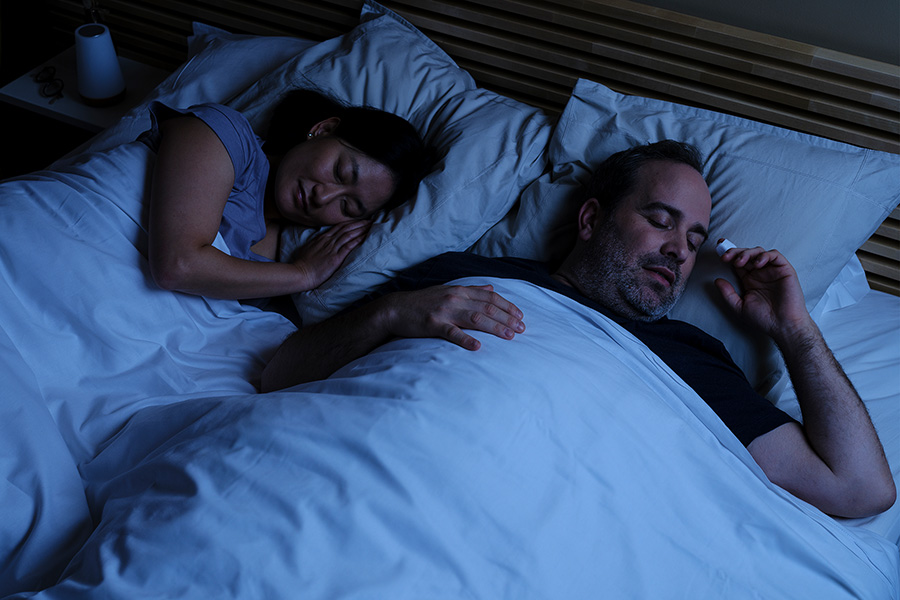Sleep studies
Sleep studies can determine whether a patient has sleep apnea or another form of sleep-disordered breathing (SDB) by monitoring breathing, body movements and responses overnight. Sleep studies can be undertaken in the patient’s home or at a sleep clinic. Each will require you to provide a referral or prescription for patients to pass on to the sleep study provider.
How Sleep Studies Measure Sleep Apnea
Sleep studies measure the severity of your patient’s condition according to an apnea-hypopnea index (AHI), which refers to the number of apneas and hypopneas that occur per hour. The diagnosis will also take into account the patient’s oxygen desaturation and excessive daytime sleepiness.
| Severity | AHI (per hour) |
|---|---|
| Normal | <5 |
| Mild | 5 to <15 |
| Moderate | 15 to <30 |
| Severe | 30+ |

Sleep disordered breathing (SDB)
SDB describes a group of disorders characterized by abnormal respiratory patterns (e.g., the presence of apneas or hypopneas, as defined below) or insufficient ventilation during sleep. In both cases, SDB consistently disrupts the patient’s sleep pattern, leading to feelings of tiredness and exhaustion. It may also put excessive strain on the nervous system and vital organs.
An apnea is when a patient stops breathing for 10 seconds or more, and wakes up just enough to take a breath. A hypopnea occurs when a patient doesn’t stop breathing, but the breathing becomes shallow (i.e., at least a 30% decrease in airflow) for 10 seconds or more, with an associated oxygen desaturation or arousal.

Facility-based sleep studies
What can patients expect from a sleep study? In a clinic, hospital or sleep lab, clinical staff will place sensors:
- On the chest to monitor heart activity
- Close to the eyelids to measure eye movements that help indicate if the patient is in REM or non-REM sleep
- On the head to measure electrical signals from the brain
- On the legs to assess muscle activity
Patients will also be fitted with:
- A nasal cannula to monitor breathing
- An oximeter on their finger to record oxygen levels
- Bands around the chest and stomach to measure breathing effort
With your patient’s permission, staff may also request to film the sleep study to gain more insights into the patient’s sleeping behavior. During this type of study, your patient will be required to stay overnight at the facility, so they should take everything needed for their usual sleeping routine, including pajamas and toiletries.
Resmed’s latest sleep lab solution features the EasyCare Tx 2 titration software bundle, which includes the TxLink™ 2 network appliance and is compatible with the AirCurve™ 11 VPAP™ Tx device. It also offers flexible installation service options, including free self-service or paid virtual and onsite support. This comprehensive solution is designed to treat a range of patients, supporting comfortable, uninterrupted sleep for effective titration, and helps sleep labs deliver optimal care at the forefront.

At-home sleep studies
A home setup is similar to that in a clinic, hospital or sleep lab – with the added comfort and convenience of staying at home. Prior to the night of the sleep study, a sleep clinician will have shown your patient how to apply the sensors and monitors, and how to use the recording device during the night.
On the night of the sleep test, the patient should simply follow a normal evening routine, then attach the monitors and begin the recording before sleeping. In the morning, they simply remove everything as shown and return the recording device to the clinic, hospital or sleep lab.
Not all home sleep test devices need to be returned to the provider. A simpler home setup can be performed using NightOwl™, Resmed’s fully disposable, non-invasive home sleep test equipped with a small sensor that wraps around the index finger of the patient. NightOwl can record up to 10 nights of sleep data* with a simple, streamlined experience that delivers a highly accurate measurement of sleep health.
Reimbursement for sleep studies
Medicare covers the cost of some diagnostic sleep studies, but there may be a gap payment. It’s best to advise your patients to check with their clinic and/or health insurance provider. Go to https://www.medicare.gov/coverage/sleep-studies for more information.
* Based on an 8-hour sleep duration per night.




